Edge of the Knife: The film in a language only 20 people speak
- Published
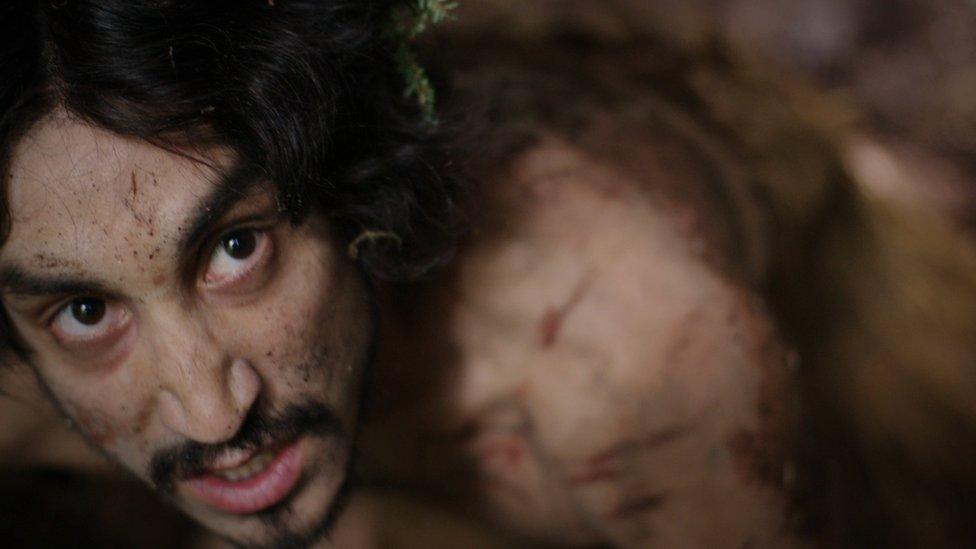
The protagonist of Edge of the Knife, Adiits'ii, as he begins his descent into madness
On a wintry beach lined with conifers, the body of a teenage boy washes up on the grey sand. A mother runs to her dead son and clutches him to her chest, wailing.
Meanwhile, a young man named Adiits'ii flees from the scene, running into the forest, gasping and grunting. Having taken the boy out in a boat which hit choppy waters, he feels responsible for his death.
It is this family tragedy that serves as the focus of the Canadian film Edge of the Knife, or Sg̱awaay Ḵ'uuna. The story, steeped in the supernatural, centres on the universal themes of family, love, loss and betrayal.
What is less universal is the language of the film, Haida. According to the First People's Culture Council, there are only 20 remaining fluent speakers of this language, making it critically endangered.

Helen Haig-Brown and Gwaai Edenshaw, who is Haida himself, directed the film.
Writing the film in Haida "did not even feel like a choice", said Gwaai. "We were telling a Haida story."
Although they were "fully committed to the storytelling", he said, another consideration was that Edge of the Knife would act as a learning resource.
Diane Brown is one of the last remaining speakers of Haida and acted in the film.
"Our dream right at the start was it would help our children learn the language. That we help teach them," she said.
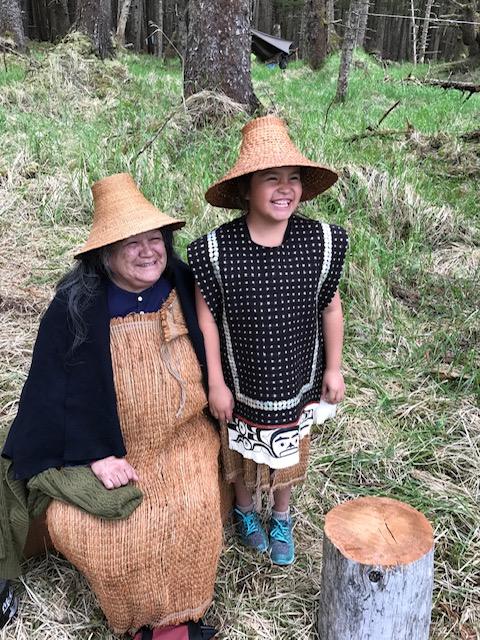
Diane Brown and her granddaughter Xyaalaa Emma, who played Eagle Child in the film

The indigenous Haida communities live on Haida Gwaii, an archipelago 100km (62 miles) off the west coast of Canada. Edge of the Knife is set in this sparse but beautiful coastal landscape in the mid-1800s.
In the film, two Haida communities come together to prepare food for the winter. Geometric patterns are tattooed across their chests and they wear cloaks woven from the spruce trees of the land around them.
It is a delicate portrayal of a family unaware of the suffering soon to strike. The Haida Gwaii archipelago was colonised by the British in 1853, who named it the Colony of the Queen Charlotte Islands.
Many believe that the Europeans deliberately spread diseases such as smallpox by giving the Haida people infected blankets and scarves, causing the population to plummet from approximately 10,000 to just 588.
This brutal annexation is foreshadowed in the film by Adiits'ii's journey into the forest, where he descends into madness and becomes Gaagiixid, the Wildman, losing his entire sense of self.
Allow YouTube content?
This article contains content provided by Google YouTube. We ask for your permission before anything is loaded, as they may be using cookies and other technologies. You may want to read Google’s cookie policy, external and privacy policy, external before accepting. To view this content choose ‘accept and continue’.
Throughout the 20th Century, the Haida population crept back up and now stands at 3,442. But Haida suffering was far from over as their culture was stamped out, particularly in residential schools, where indigenous children were forced to work all morning in the fields then given rudimentary lessons in the afternoon. Speaking Haida was strictly forbidden.
Diane Brown said that her parents were told by teachers that if they spoke "their language" they would go to hell. Some children were beaten for speaking their mother tongue.
"It was a way of trying to control us," she said. "A grand plan to assimilate us 100%."
Gwaai said that most Haida still "understand their situation to be one of foreign occupation and are frustrated with their incapability to speak their own language in their own land".

Haida: A short guide
Haida, or X̲aad Kil / X̲aaydaa Kil is mainly spoken on the islands of Haida Gwaii in British Columbia and dates to when people first settled there after the last Ice Age, about 11,000 years ago.
There are three different dialects of Haida, spoken in Skidegate and Massett in Canada and Hydaburg in the US state of Alaska. Haida is an isolate, meaning it does not connect to any other existing language.
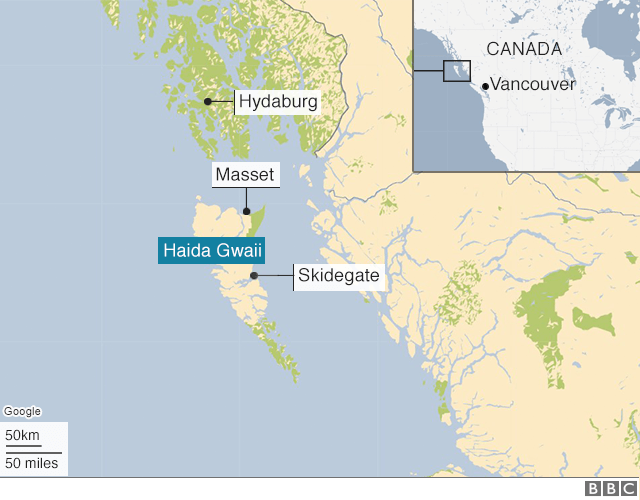
Haida phrases
Siing.gaay 'laa - Good day
Gassingu dang giidang? - How are you?
Asang dang hll ḵing gas ga - See you later
Gasanguu siingaay giidang? - How's the weather?
Gina 'waadlux̱an gud ad kwaagid - Everything depends on everything else (a well-known Haida saying)

According to Unesco, there are 70 recognised indigenous languages in Canada. The First Peoples' Cultural Council says that almost half of these are in British Columbia, which has an indigenous population of 172,520. But only 3% of this population speaks an indigenous language fluently.
This reflects the international picture: a report by the National Geographic Society and the Living Tongues Institute for Endangered Languages found that across the world, a language dies every two weeks.
The United Nations declared 2019 the International Year of Indigenous Languages and funding to preserve them in Canada has increased from $5m (£3.9m) to $118m (£91.2m) in recent years.
Robert-Falcon Ouellette, a member of parliament for Winnipeg, believes the fight to protect threatened languages is a worthwhile cause.
He is of mixed English and indigenous Cree descent and is one of the few politicians to have spoken in his native language in parliament in 2017. He said that everyone has a right to their own language.

Robert-Falcon Ouellette speaking in his Cree dialect in parliament

"There's value to people whose language is their culture and their history," he said. "We often hear that indigenous people don't feel part of Canada. There's an awful lot of anger."
Robert-Falcon's Cree speech paved the way for MPs to have the right to interpreters to translate indigenous languages in parliament. In March, the aboriginal television network APTN broadcast a hockey game in Cree for the first time.
According to Robert-Falcon, using indigenous languages, whether it is in film, parliament or sports, is "the chance to tell indigenous people that they matter".
Erica Jean Ryan was an actor in Edge of the Knife, as well as the on-set language coach. She is Haida and started learning the language eight years ago.

Erica Jean Ryan (R) on set in traditional Haida clothing
To hear Haida spoken for the first time in the film, as a native English speaker you might assume that the process of learning it was very difficult.
But Erica said the process was less like learning and more like drawing out the language into her consciousness. "I had no problem with the pronunciation," she said. "It was already in me."
For the 22 non-Haida speaking actors in the film, "boot camps" were arranged for the elders to teach it to them.
"We brought actors and speakers all together in one place, off-grid, for two weeks," said Erica. "They learned how to speak, how to memorise the language. To do the language justice and give our ancestors justice."
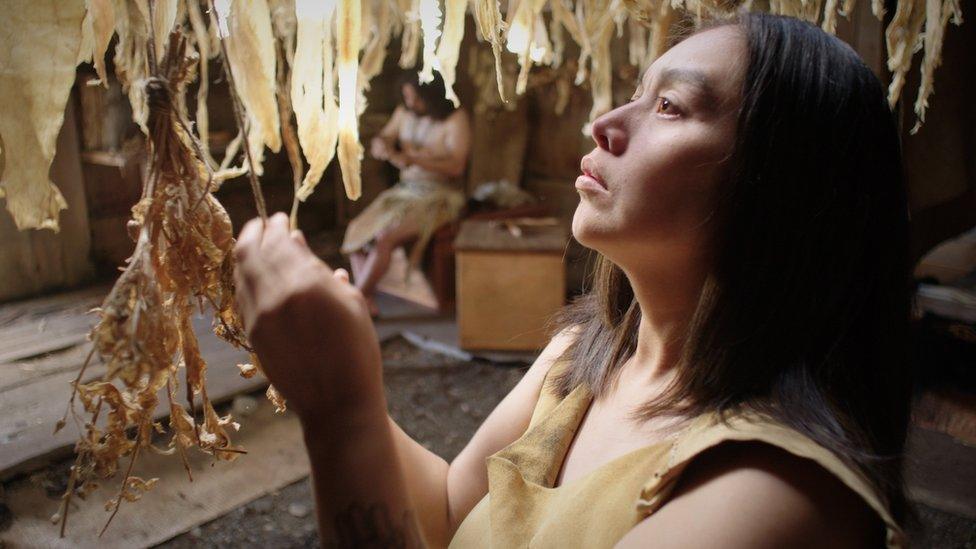
A scene from the film showing Hlaaya, the mother of the boy who dies, drying leaves to prepare them for weaving
Like Haida, many languages are passed from generation to generation orally and do not have an orthography to preserve them. But now, for the first time, Haida has been written down - an important tool to help new learners.
As for the script, the writers first wrote it in English then took it to the elders to translate. Erica described the elders as the "the heartbeat, the backbone" of the project and said the production team needed to "harness their knowledge and give them the floor".
Haida now has 265 active learners. For the first time, it is also being taught in schools. As such a relatable medium for younger generations, film is a crucial part of this educational process.
"It's gained way more interest than we ever dreamed it would," said Diane Brown. "Young people are interested in it." She saw evidence of this with her own grandson who has since learned Haida. "It gave him a sense of pride in who he was as a Haida," she said.
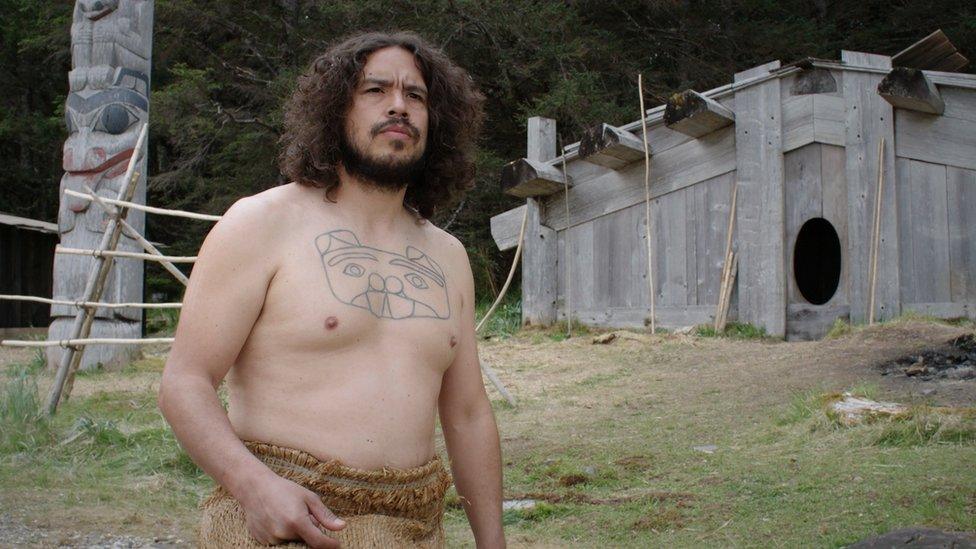
A Haida man stands in front of their traditional wooden housing in a scene from the film
"It's inspiring further generations; it's opening minds up," said Erica Jean Ryan. "This film gives hope to other languages and other indigenous communities. If you can pave that way and be that baton then we have got to do it."
For Erica and all the Haida people involved in the film, after so many years of having such a crucial part of their identity destroyed, reviving the language has been an emotional process.
"The language has healed me - made me feel whole, made me realise what it means to be Haida," she said. "That's how I'm going to help my people, help my kids."
- Published15 September 2010
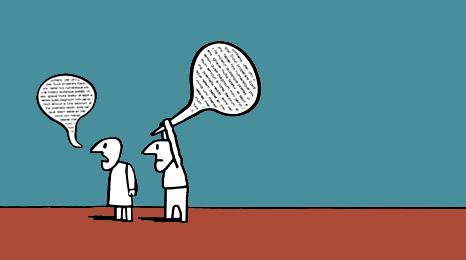
- Published3 September 2014
.jpg)